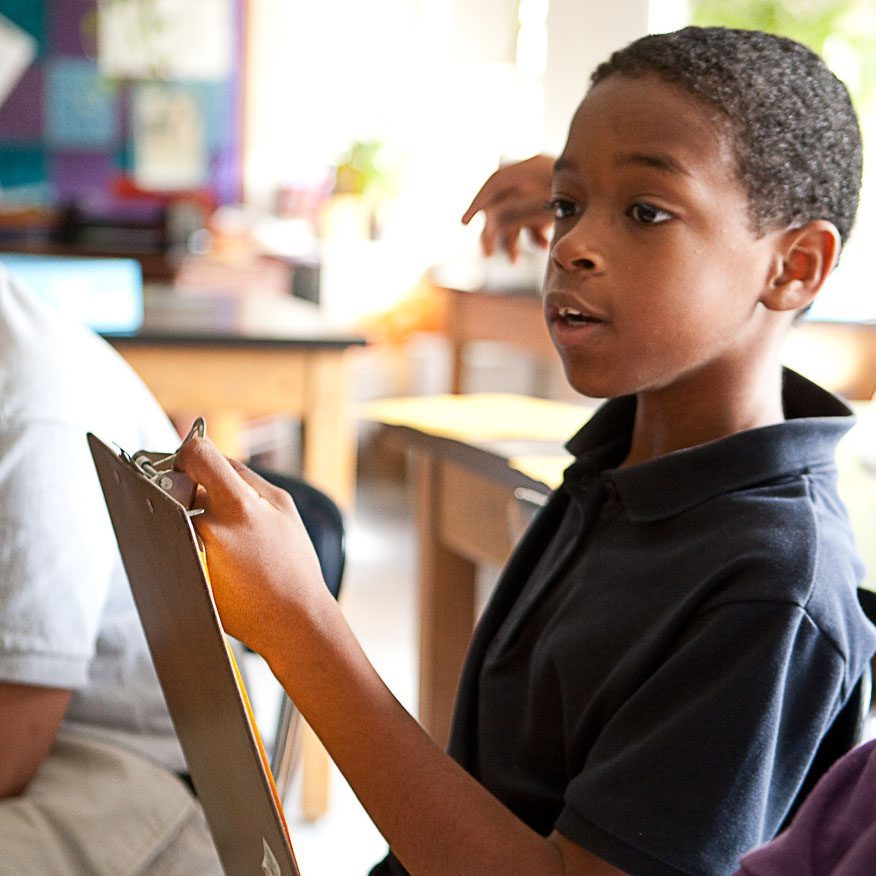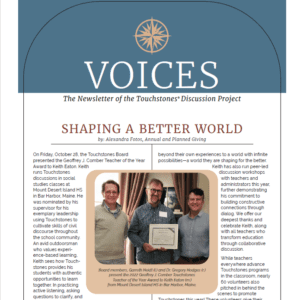3 Practical Ways to Help Students Build Active Listening Skills
In today’s post, we’re continuing our ongoing series highlighting the Four Stages of Group Development in Touchstones with Stage 3: Active Listening. When thinking about what makes a good discussion, active listening is often the first skill that comes to mind, and in our workshops, it’s one teachers routinely say is most important for their students. It might seem strange then, that Touchstones sees this as Stage 3, rather than Stage 1. But listening is a complex activity that requires much more from us than just our sense of hearing or even particular body language. At Touchstones, we think of Active Listening as striving to understand what a speaker or author means to convey without putting our own lenses or assumptions on it. In a discussion group with participants of all ages, we first have to overcome the barriers to participation and cooperation by building enough trust and practicing enough self-awareness and self-regulation to ensure that every group member knows their voice belongs and will be heard. Only then can we begin to work on active listening. In this post, we’ll dive deeper into the goals of the Active Listening stage, how you can recognize when your students are exhibiting Active Listening as a group, and offer strategies to help you support your class in building these Essential Skills.
How do you know when students are engaged in Active Listening?
So often when we think we’re listening, we’re actually just waiting quietly until it’s our turn to share, or planning a rebuttal that lets someone know why what they’re saying is wrong. Our prior experiences and understanding of the world color how we hear what others say and how we read what others write. We unconsciously impose our own categories and perspectives—often without much self-awareness—and we fail to see the actual meaning of others’ words. Active Listening comes from a place of curiosity instead. It happens when discussion members are both respectful and purposeful; when their comments and questions seek to establish the meaning of what is being shared rather than merely to advance their own ideas. Signs of Active Listening include when members of the group ask the speaker to rephrase something or explain a statement more clearly. Questions or comments that connect what has just been said to what has been said earlier are also signs that students are engaged in Active Listening. These behaviors not only indicate that the listener is intent on hearing the speaker’s words, but they also show that the listener is attempting to comprehend the speaker’s idea or perspective. When your class is consistently exploring the meaning of ideas together, acknowledging others’ opinions, or accepting differing viewpoints, you’ll know they’re engaging in Active Listening.
How can I build Active Listening with students?
Active Listening is a skill everyone can work on, and to get there we must learn to examine their own assumptions and perspectives. This starts with students beginning to separate their own ideas from those that are articulated by other people. Help students practice this by asking: What do I think about this theme and where did that idea come from? Understanding what it looks and feels like for each of us to listen and be listened to is another step. We have probably all had the frustrating experience of being misunderstood by someone. Sometimes it is because the other person isn’t paying careful enough attention, and at other times it is because we have done a poor job communicating. Alternatively, we all have experiences where we really felt heard. Help students think about this idea by taking some time to reflect on what was different in those moments. How were you communicating your thoughts, and what did the other person do to let you know they were listening? We’re including a few more strategies below.
Ask clarifying or connecting questions
Active listeners demonstrate curiosity and an open mind by beginning with questions, rather than interrupting or criticizing to argue their point right away. As the discussion leader, you can model this for your students – in any stage of group development – by asking questions. These could include questions to clarify the meaning of the text, to help the speaker make their point more clearly, to connect different threads of the discussion, or to better understand what the speaker is trying to communicate. Try some of the following:
- Could you give a different example?
- Could you say more about what you mean?
- Can we think of a time when that isn’t true?
- How does what James just said connect to the point that Keisha made earlier?
Turn statements into questions
Challenge students, especially those who already feel confident in their speaking to turn their statements into questions. This subtle shift moves the group from only hearing the speaker’s ideas to inviting more voices and perspectives to come in. Students can easily change statements to questions by moving the verb to the beginning or putting the phrase “What would happen if…?” or “What do you think about….?” before their statement
Communicate our own views clearly and concisely
Active Listening is also about making sure that what we say can be readily understood by others. In order to be understood, each student must also make an effort to articulate ideas in a way that others can readily understand. Long and elaborate explanations or meandering thinking can be hard to follow in a discussion. Instead, shorter and simpler statements help the group to move deeper into the ideas. Challenge students who struggle with concision to write down their initial thoughts as part of the Individual Work or encourage them to use specific examples when sharing. If students have an idea that is not fully formed, but they think is important to the discussion, encourage them to explicitly ask for support from the group in fleshing out. Ex: “I’m thinking about…, but I’m not totally sure yet. What do others think?”
Share this post and let us know your strategies for cultivating Active Listening with students. If you’re interested in adding more to your toolbox, join us for an upcoming workshop or our Summer Educator Summit.
This post is the third in a series on The Four Stages of group development. Check back in May for the next and final post focusing on Collaborative Leadership.




 Join the
Join the